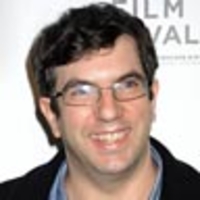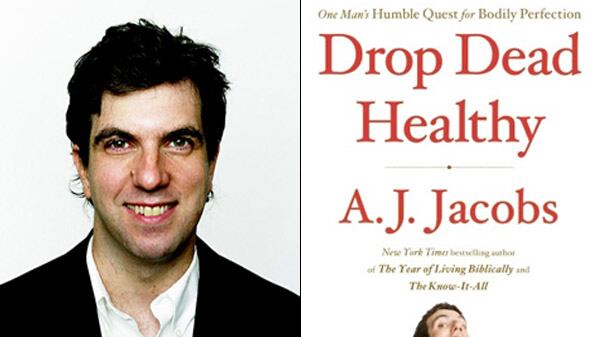Of all the workouts I’ve tested out—among them yoga, upside-down yoga, Strollercizing, and the ultra-hardcore Crossfit regimen, whose mascot is Pukey, since extreme nausea is the sign of a successful session—my favorite might have been the Caveman workout.
The Cavemen–or the Paleos, as they prefer to be called–are still somewhat fringe, but they’ve been gaining traction. The idea is simple. Our bodies evolved for millions of years to eat and exercise a certain way. We need to go back to the old techniques—exercising in nature and eating like cavemen.
It’s an easy trend to mock. My friends have done so relentlessly: “Is part of the workout dragging women by their hair?” “What was the life expectancy of the caveman? Twenty-eight years? Good luck with that.” (Actually, the length of their lifespan is debatable.)
I’m skeptical of much of the caveman dogma—especially the parts about the meat-heavy diet. But I don’t think the Paleos should be dismissed and I want to give their workout a shot.
The guy behind the caveman workout is a 39-year-old Frenchman named Erwan Le Corre, whose company is called MovNat, short for Mouvement Naturel.
He holds workshops around the world—from West Virginia to Thailand—and today he’s in New York. We meet at 108th Street and Central Park West at an entrance to the park.
Erwan bounds up wearing black shorts and a sporty zip-up sweater. He’s ridiculously good-looking, in a leading-man-in-a-1950s-MGM-movie way: a razor jaw, perfectly coiffed hair, muscles that are well defined though not steroidy.
“This is a great place,” he says, with a strong French accent, as he scans the scene. “Very natural. Very primal.” He runs up the hill to scout out the best patch of trees and rocks.

I wait on the corner with two other cavemen:
One is John Durant, a 26-year-old Harvard grad with dark shoulder-length hair and blue camouflage shorts. The other is Vlad Averbukh, a 29-year-old with short reddish hair and a short reddish beard and an accent from his native Uzbekistan.
John and Vlad know each other well, having both appeared in a New York Times article on the caveman movement.
They chat amiably for a few minutes. Then Vlad starts pressing John on doctrinal differences. Vlad thinks that Paleos should be eating raw meat. His diet includes a lot of raw beef and internal organs. John thinks fire was invented much earlier, and cooking your meat is just fine.
“What are your sources?” Vlad asks John.
John sighs. “I don’t want to have this debate now.”
Vlad seems annoyed, and walks off. I get the feeling Vlad is the fundamentalist caveman, and John is the reformist caveman.
Erwan is ready. We leave our shirts in a pile near a rock. It’s a brisk day, and I clasp myself in a self-hug, hoping to warm up.
“Why do we go bare-chested?” asks Erwan. “It’s better for us. It toughens us up physically, which toughens us up mentally.”
There are five of us total, including an African-American caveman named Rahsaan. We jog in place to keep warm.
Vlad leans in to me and says, “I’m glad you’re here. Because otherwise I would be the least built of everyone.”
He glances at my chest again to make sure.
“Uh, thanks?” I say.
“I didn’t mean that as an insult. I am just stating facts.”
Erwan gives us a pre-workout talk on the importance of exercising out in nature. He points to the rocks and hills and uneven ground. “This is better than a gym. It’s adaptive for our bodies and our brains. At a gym, you do one muscle, then another muscle.”
He mimes a biceps curl. “It’s not only inefficient, it’s boring.”
Our first exercise will be running. We go in single file, crunching through the leaves, dodging broken bottles and jutting rocks with our bare feet.
We’re supposed to run elegantly, like an animal. Keep the muscles relaxed, lean forward and let gravity pull you ahead. Don’t stomp—take short steps and land lightly on your toes. Don’t pump your arms, just let them dangle naturally by your side.
It feels the exact opposite of natural; being used to my old arm-pumping, foot-stomping self. But maybe it’ll become natural.
As we round a tree, I step on a glass splinter, barely suppressing a yelp. I don’t tell anyone, as I don’t want to be the whiner. When we come full circle, we stop to catch our breath.
For our next exercise, we get more primal. We get down on all fours and clamber along a 40-foot fallen log. The idea is to move as if you’re a tiger stalking prey. Erwan hops on the log, keeps his back board-straight, and prowls away.
I follow. It’s tricky. My foot keeps slipping, and it’s a strain on my shoulders. I try to prowl like a cat, but end up scurrying like a monkey.
We dismount, and Erwan gives us another pep talk. “In yoga, they say that they the mind and body are in touch.” He does a mocking California surfer-dude accent here—or at least a surfer dude from Provence. “That’s fine. But that’s not enough. You need to have a mind-body-nature connection.”
During a break, Vlad asks me, “What’s your body fat? My guess is it’s 18 percent.” I tell him I haven’t measured it in a bit.
“You have a lot of intravascular fat—fat in between the muscles. If you were a cow, I could make a lot of tallow out of you.”
“Uh-huh.”
I know I should be angry. So far Vlad has insulted my body twice in the span of a half hour. But there’s something disarming—maybe even charming—about his complete lack of social graces. He’s like my 5-year-old.
The talk turns to diet, as it often does in caveman circles. Vlad extols the virtue of raw grass-fed beef.
“I’ve found a great supplier of cow brains,” he says. Rahsaan is interested. “Will you email me the info?”
As you might imagine, Vlad has no patience for vegans. He’s dated a couple over the years. “I converted one to Paleo on the first date—but it didn’t work out.”
The lack of women in the Paleo movement is a recurring source of frustration. Vlad tells how he had a date over to his apartment, but she left because she thought the bathroom was too dirty. Vlad disagrees with her.
For the first time, I feel a bit bad for Vlad. I want to tell him that it might be easier to date if he was a little more flexible with his no-hygiene-products rule. He won’t use deodorant or toothpaste. “I will floss my teeth because chimps have been known to floss their teeth.”
For the next exercise, someone suggests lifting a boulder, but we have trouble finding large rocks. Erwan thinks it would be better if all of us carried a log on our shoulders.
We get in line, and on the count of three, we heave a log onto our shoulders. It’s as thick as a telephone pole, and my knees buckle a bit before I regain my balance.
After we stagger forward about 10 yards, Erwan shouts that it’s time to toss it back onto the ground. We all grunt, and the log thumps to the dirt.
Vlad approaches Erwan. “What can I do about this?” Vlad asks. He points to his shoulder, which he’s scratched up while carrying the log. Erwan shrugs. Perhaps put some salve on it. Maybe aloe vera, someone suggests.
“Use the blood of your enemies,” says John.
We all laugh, except for Vlad. I feel the tribe fracturing. I’m worried for Vlad. I want him to censor himself and get back on the good side of the alpha males, but I don’t know if he can.
Our final exercise will be sprinting. In Paleolithic times, the theory goes, there wasn’t a lot of jogging. There was walking, then sprinting. You’d sprint from a hungry tiger, or sprint to catch an antelope. Our goal is to imagine ourselves fleeing from a predator.
We, a pack of shirtless guys, start on a bike path. Erwan gives a signal and we all sprint across the street at a diagonal angle, dodging bikers and in-line skaters, pumping our legs, then hopping over a short wooden fence on the other side.
Erwan smiles widely. “You feel alive? That’s the way to work out. No warm-up. Just sprinting!”
You know what? I do feel alive. That was fantastic. Liberating. I can feel my heart expanding and contracting. I can feel my skin tingle.
A gray-haired women approaches us to ask us why five half-naked men are running through the park. We try to explain. “Oh, I thought you were robbing someone,” she says, matter-of-factly, and then leaves.
We walk back across the street to prepare for another sprint.
“Can we start on smoother pavement?” asks Vlad. “This hurts my feet.”
“Listen,” says Erwan coolly. “Toughen up.” Everyone laughs, except Vlad.
“For someone who boils their meat, that’s talking pretty tough.” Vlad shoots back.
Vlad turns to John: “And I can tell you trim your chest hair.”
“I’m not sure what your fascination is with my chest hair,” responds John to a tense silence.
We sprint through the bikers again, jumping over the fence. And that’s it. Three hours of huffing and puffing in New York’s woods. I’m cold and tired, and I have to take care of my cavekids.
As we say goodbye, Erwan asks again about the premise of my book. “It’s about me trying to be the healthiest man alive.
“I’m not trying to give you a hard time,” Erwan says, with a smile. “But I am being the healthiest man alive. Not trying. Being.”
When I get home, I spend 20 minutes digging the glass splinter out of my toe while telling my wife about Vlad and his insults.
“So will you be running around with a loincloth from now on?”
No. Probably not. But the caveman workout shouldn’t be dismissed. For one thing, I have to concede that Erwan has a point about exercising under the sky.
I’ve always preferred the indoor life–to quote Woody Allen, I’m at two with nature–but that’s not going to work this year. Recent research shows that just being outside improves your health, at least for those without debilitating hay fever. A Nippon Medical School study showed that two-hour walks in a forest caused a 50 percent spike in natural killer cells, a powerful immune cell.
A 2010 study asked 280 subjects in Japan to take strolls in both the park and the city. After the nature walks, the participants showed lower “concentrations of the stress hormone cortisol, lower pulse rate, lower blood pressure.” Strolling through parks is apparently a popular hobby in Japan, and goes by the poetic and slightly racy name of “forest bathing.”
What’s so great about the great outdoors? One theory is that plants release a chemical called “phytoncides.” Plants use it to protect themselves from decay, but it may benefit people too.
It may be simpler than that. It may be that the very sight of nature calms us down. There’s a famous 1982 University of Michigan study in which patients recovering from gall-bladder surgery stayed in different hospital rooms. Some had a view of a green field, some had a view of a brick wall. The ones with the natural view recovered more quickly and required less powerful painkillers. They even liked their nurses more. Come to think of it, maybe that’s why I even liked Vlad.




